When we covered Ivy-inspired clothing in a recent Reader Profile, there were some slightly dismissive comments about Ivy as a whole.
Given I’ve found that tradition particularly inspiring in the past five years, I thought it might be worth setting out what Ivy clothing I like and don’t like, and why.
I honestly think – as I said during our Ivy Symposium in New York a few years ago – that its principles have the greatest potential of any tradition in helping men dress well today: personally, elegantly and yet playfully.
Every tradition of clothing has its good and bad points - or at least more subtle and extreme ones.
I love tailoring, but I’m not a fan of braces or unusual double-breasted configurations; I love military-inspired clothing, but prefer an M65 or pair of fatigues to camo trousers or a souvenir jacket.
Ivy is no different. The brighter, louder clothing turns me off, as does the ossifying attitude of traditionalists. But the general relaxed attitude to tailoring, and combinations with sportswear, I find more inspiring than anything else.
So here are two lists: clothes I don’t wear and do wear, which may be considered Ivy.
The point is to avoid readers being turned off by the first, and as a result prevented from enjoying the second.
My Ivy is not:
- Brightly coloured trousers
- Fabrics with embroidered animals, flags or indeed anything else
- Pinned or tab-collar shirts
- Fun shirts
- Wide, chunky shoes, particularly longwings
- Madras jackets or trousers
- Suits with no darts or shape otherwise
- Blazers with gold buttons (unless, perhaps, worn with something from a different tradition, such as denim)
My Ivy is:
- Soft-shouldered tweed jackets
- Polo coats, raglan coats, duffle coats
- Flat-fronted trousers
- Oxford shirts
- Polo shirts
- Pale pink, pale yellow, purple. Not lime green or brick red
- Shetland sweaters
- Harrington jackets
- White bucks
- Low-vamp loafers (and low-vamp boat shoes)
- Cordovan
- Sports socks
- Sportswear mixed in generally: sweats, caps and so on
When styled well, it’s not hard to see how the latter list could be a great capsule for a modern guy – existing in a dressed-down environment, but still wanting to dress well.
This contrast can be seen in other ways too, such as icons and attitudes.
My Ivy is not:
- The guy wearing it head to toe: madras trousers, pink oxford, seersucker jacket
- The Polo model piling on everything: shetland, jacket, rugby around the shoulders
- The Neo-Trad overdoing it: flood pants, short jacket, pin collar
- Lee Marvin in Point Blank, with his tan brogues
- Don Draper when he wears checked jackets
- Anyone insisting that Ivy should be worn in exactly the same way as a particular decade
My Ivy is:
- Gene Kelly in sportswear, but with a collared shirt and loafers, not a tee and trainers
- Robert Kennedy wearing a flight jacket and old khakis to play touch (American) football - below
- Robert Motherwell or Jackson Pollock in their paint-spattered loafers or brogues
- Paul Weller in French Ivy
- Jean-Paul Belmondo in Breathless
- Anyone mixing sporting and more formal clothing in a playful manner
Ivy has always evolved. Some things remain pretty constant – like flat fronts – while others change, such as the width of those trousers. From Army surplus khakis, to civilian trousers, to slimmer styles in the late 1950s, they became gradually narrower.
There’s a great Talon ad from 1955 of two guys in (moderately) slim trousers mocking someone in oversized ones – who’s standing in the window of an antiques store.
It changed with the influence of Italy from the late 50s; it was different when taken up by the Mods; there was the boom in Japan from the mid-sixties; and it had a twist added by the French, and so on.
Given all these cultural re-intepretations, it’s important to note that the whole essence of Ivy, from from its start in elite US college campuses, was of mixing things together and not giving a damn. That’s what made it energetic, interesting, and last.
Ivy style is a surprisingly broad term, encompassing much of traditional American clothing, its origins and reinterpretations, purists and rebels.
But outside America that can often be missed, with the label applied to a kind of caricature of madras, fun shirts and seersucker. It’s not a very relevant or sophisticated image.
I’d encourage readers to pick and choose the things they like from Ivy and make them their own. Guys don’t need any encouragement to wear sports clothes to class, as the originators did - but they could probably do with some help elevating those clothes when they leave.
Many thanks to Jason Jules for his help with this article. If anyone wants more on that topic, the Ivy Symposium has a few good people taking about that, such as Alan Flusser and Richard Press.
And now, a pictorial story - to give an idea of direction, you understand, rather than make specific points. Remember, this is not about right and wrong, merely illustrating what I find inspiring, and what I think readers could too.
MY IVY IS NOT:


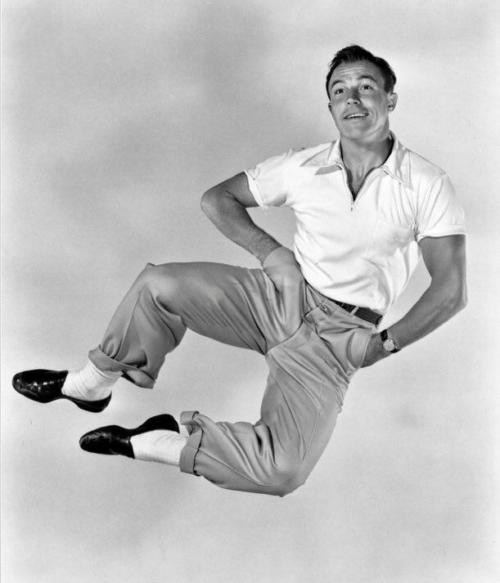
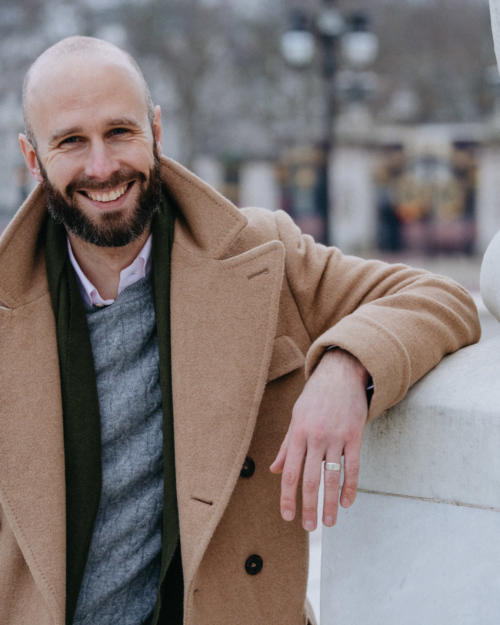
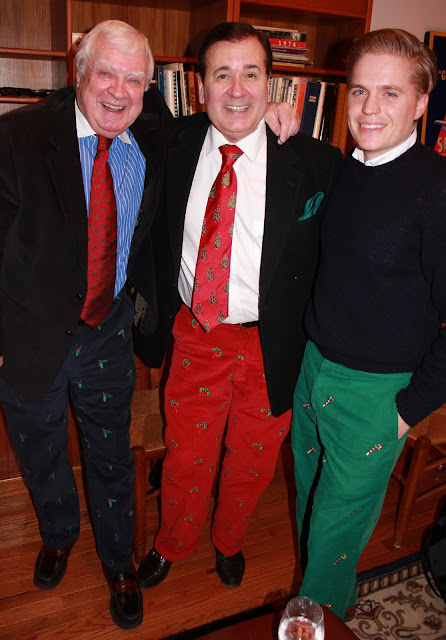
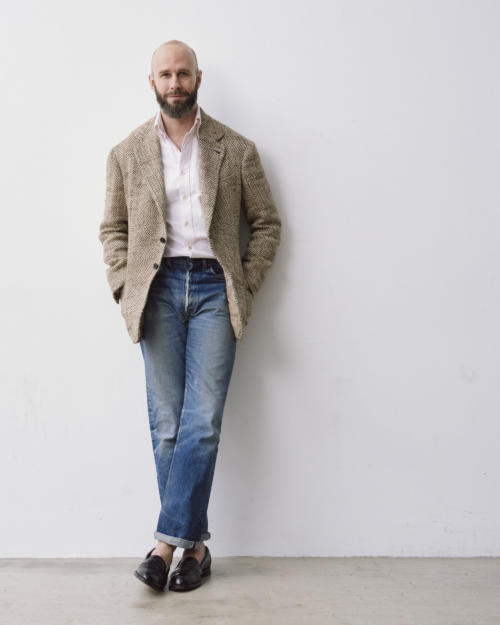
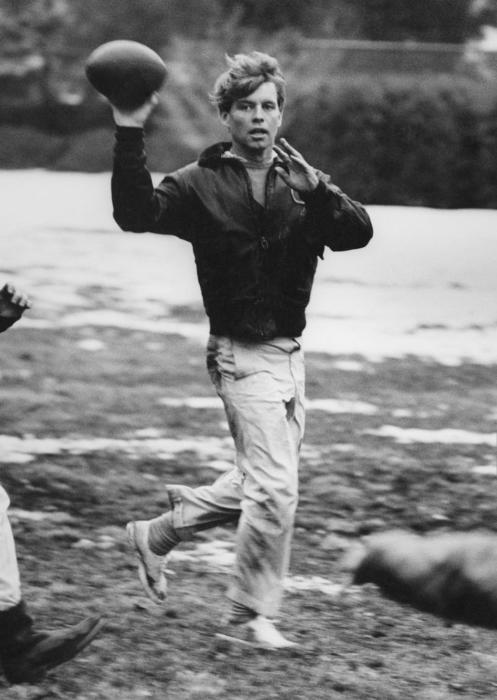
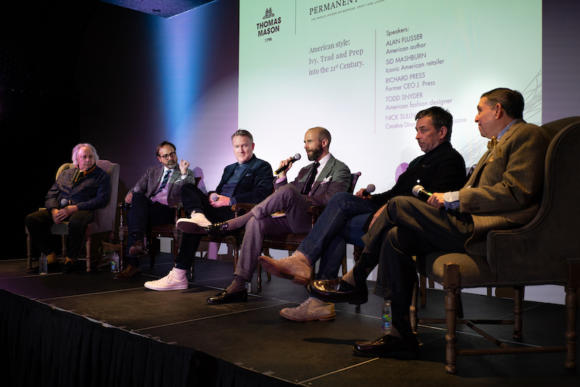
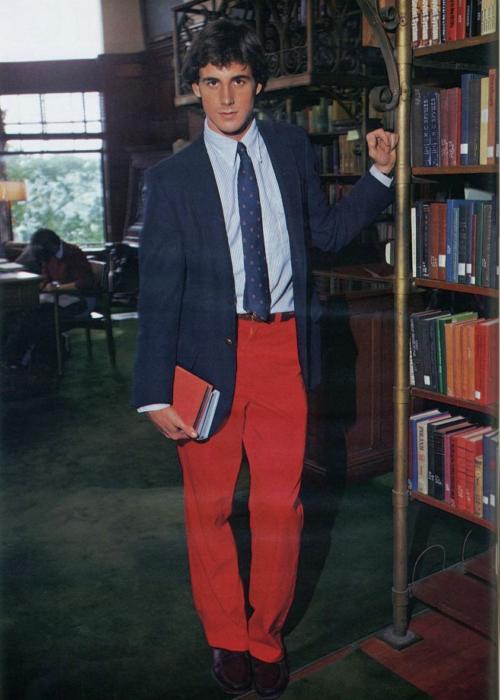
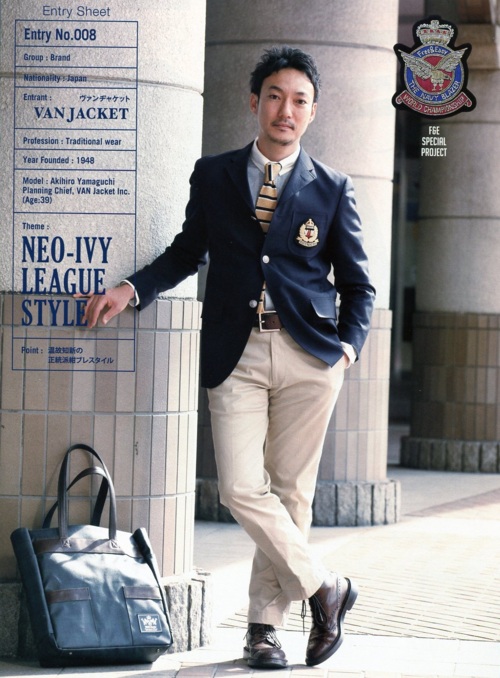
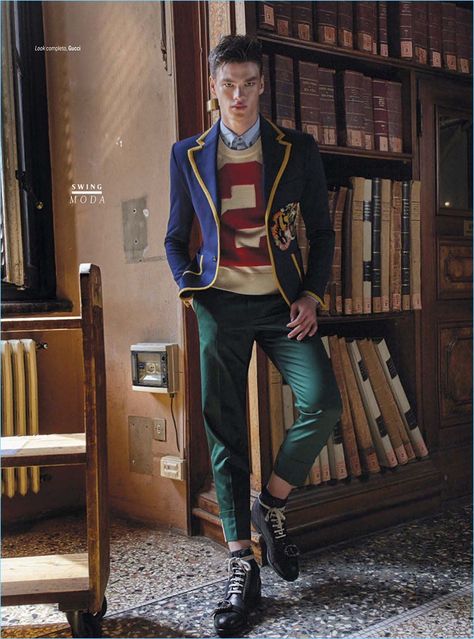
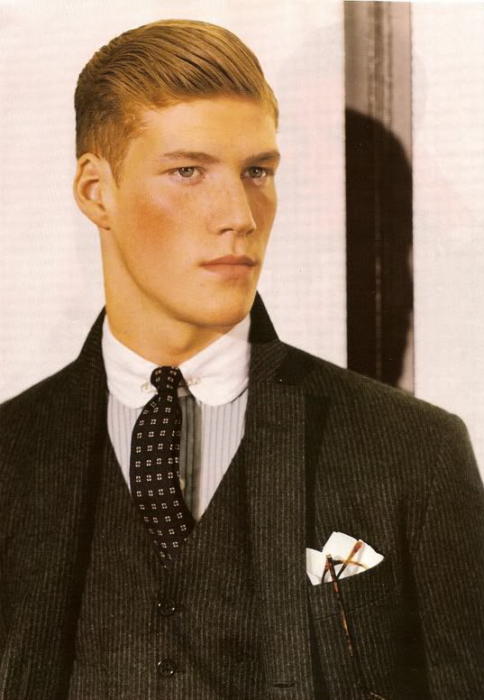
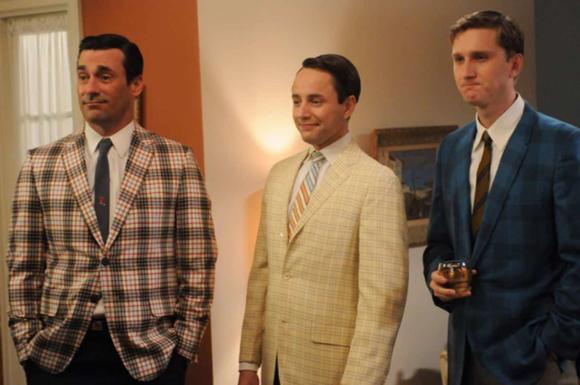
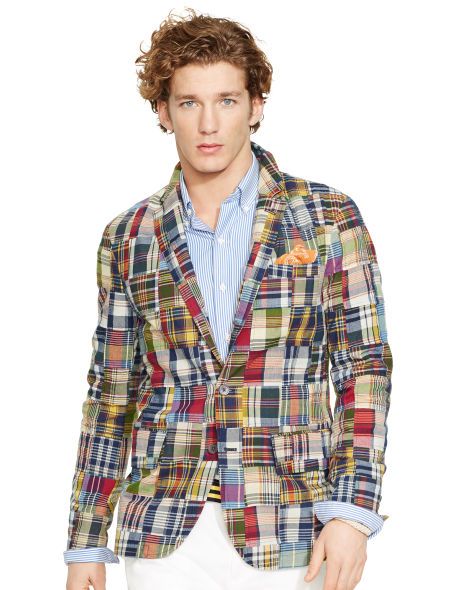

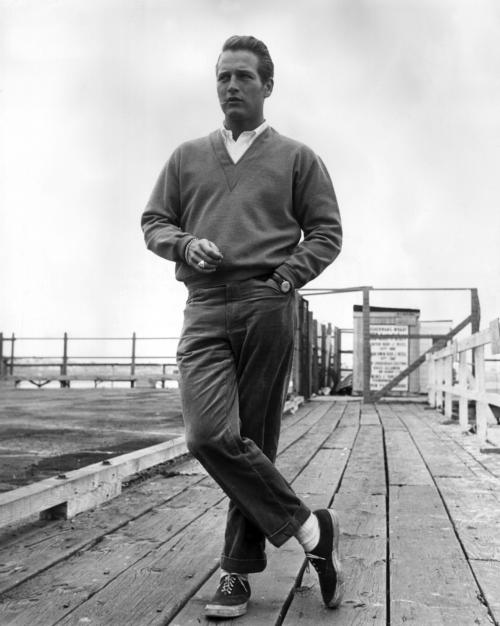
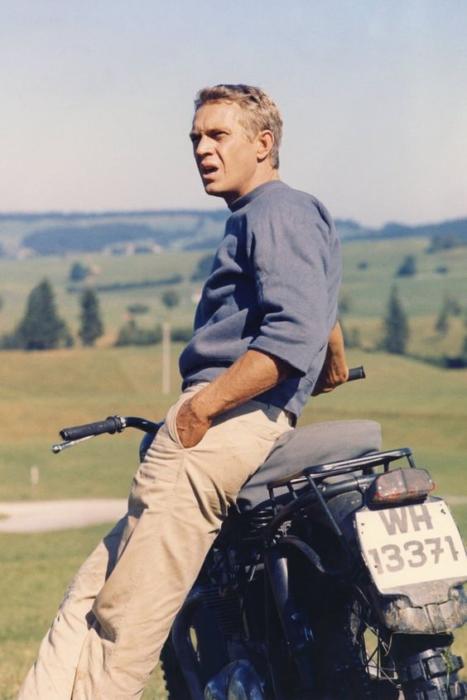
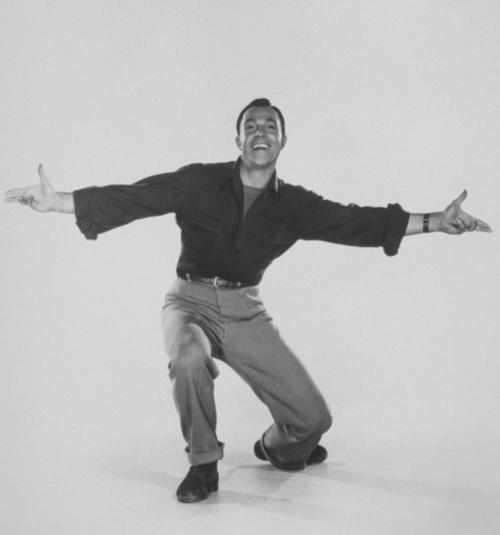
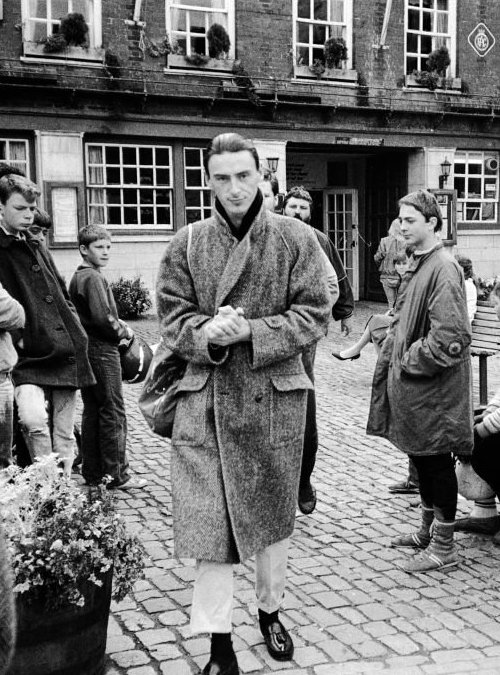
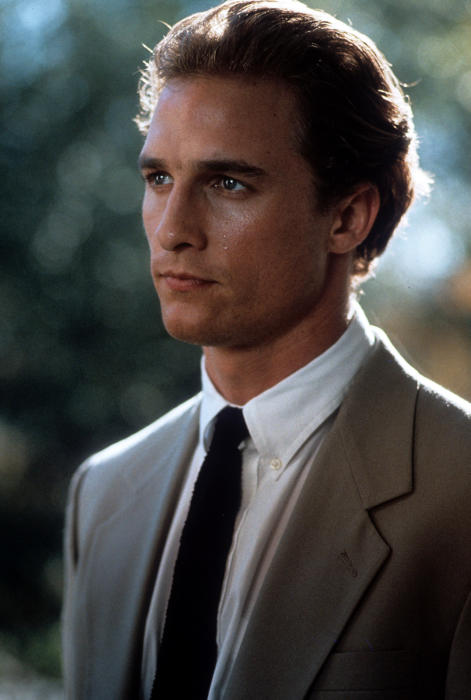
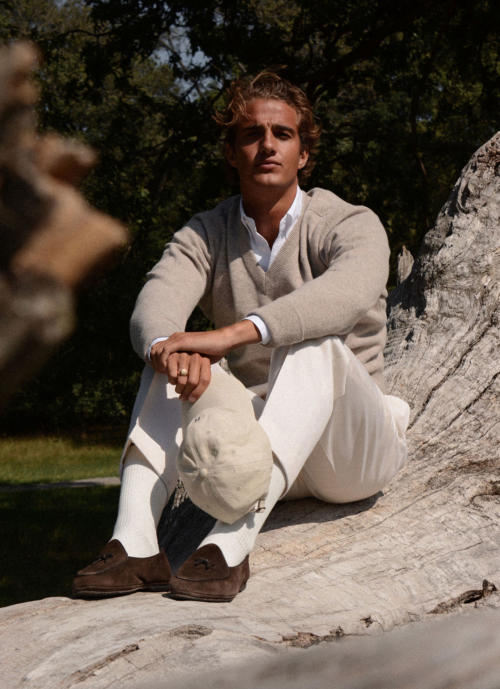
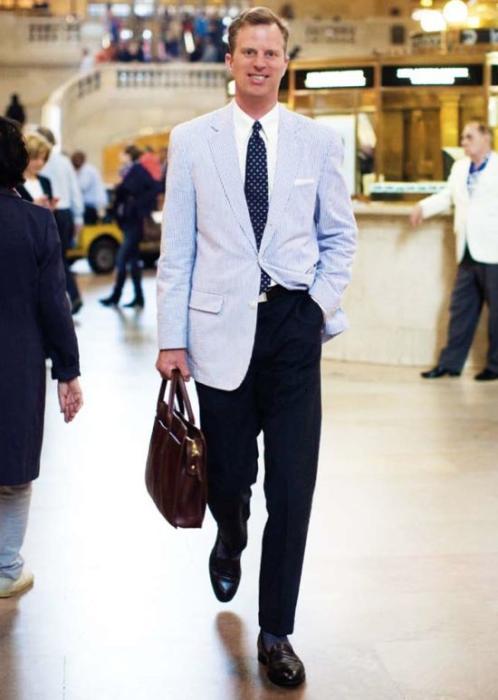
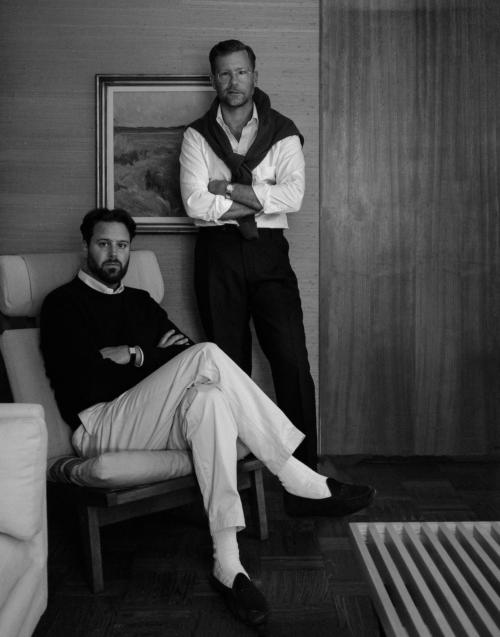
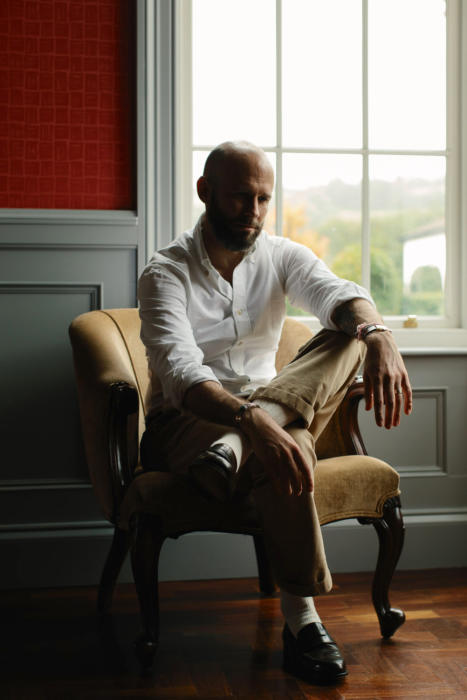
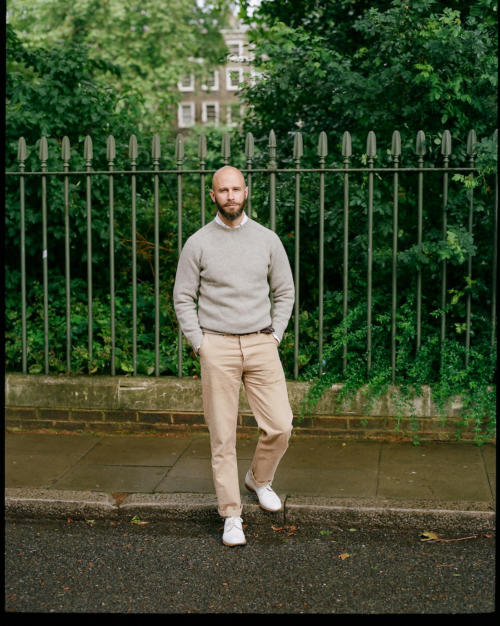


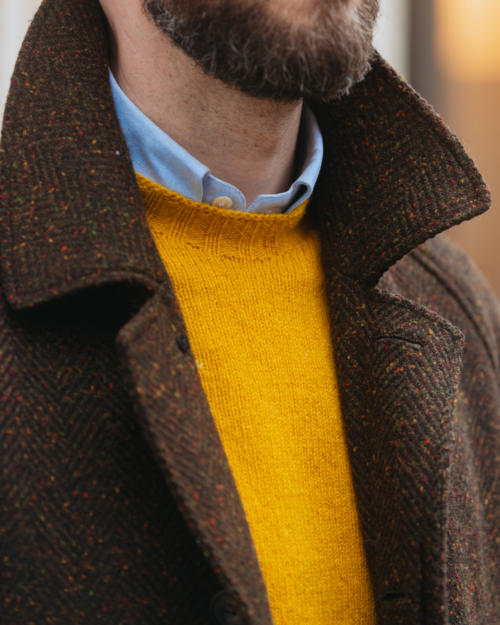
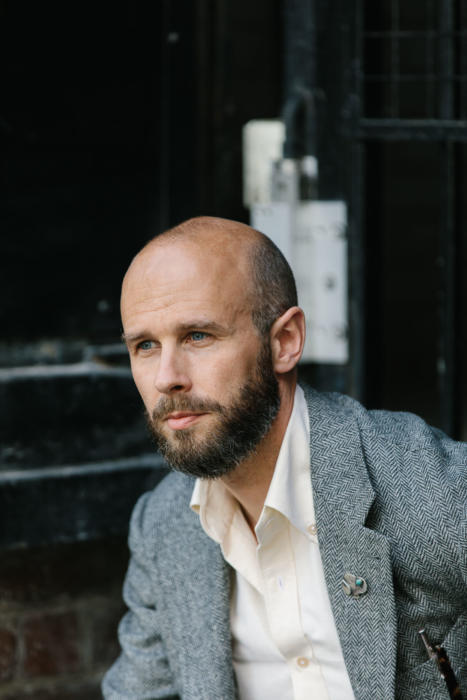
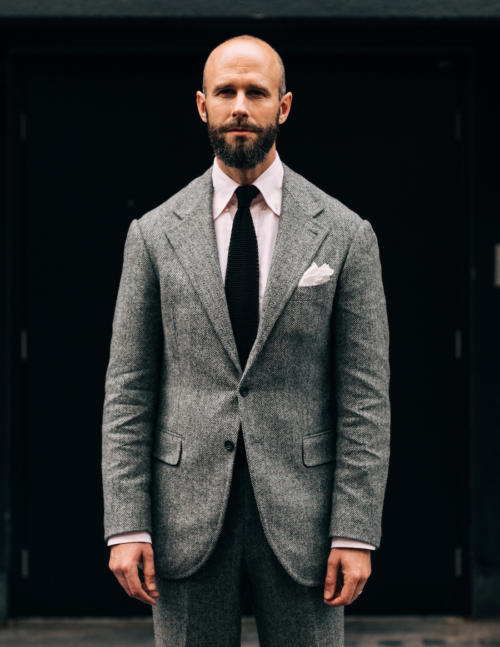


























Nice topic Simon.
In the third photo from the bottom,I just love that yellow crew neck sweater over a blue shirt. Who,if I may, makes that beautiful sweater and the shirt?
What type and colour of trousers would match up comfortably with the above?
Thanks
Lindsay
It’s a Shetland from Trunk. The shirt is the PS Oxford.
Loads of things would work below. I wore ecru jeans, but denim and grey flannels would also be great
Many thanks for that
Lindsay
I always felt the point of Don Draper’s “off-duty” costuming was to demonstrate how out of place he was in the company of his Ivy-League colleagues and therefore shouldn’t have been a source of inspiration. Contrast that shot of him in your article with how natural he appears in later seasons when he is allowed to drop the Don Draper facade and is wandering about in a simple white tee and slacks.
Good point. Shows it’s an even better representation of why I don’t like that kind of look I guess
But I really love season 1 Don at Sally’s birthday party in that short sleeve shirt…
Favourite photo is Paul Newman. Perfect. So the issue with Lee Marvin in Point Blank is just his tan brogues?
malcolm
The chunky tan brogues yes, but mostly because of the dark suit they’re worn with, and the fact that role is often used as an Ivy reference. The tie is also oddly short, but that’s very much of its time
Sorry Simon, but the brogues in Point Blank are not tan, they were oxblood .
Sorry, must be the image I was looking at. Though helpfully not a fan of oxblood either!
Nice story with photographs. I like how white trousers look with a navy blazer. I like tan Oxfords and brown. ones. Nautical and equestrian influences as presented by Ralph Lauren ads over the years . Nantucket reds that are pleated work for me this summer. Such fun learning the origins of Ivy and adapting certain elements with understanding.
Nicely put William
Hi Simon,
Even though I personally do not really do ivy specifically, except maybe odd college cardigan here and there, I’ve noticed that quite often I do tend to drift to looks that are quite similar in spirit and I guess partly for the same reasons why and how ivy first came about.
This particular need to bastardise or at least heavily casualise the good ol’ classics.
I enjoy to throw on a tweed suit with a hoodie and sneakers for example. Not really an ivy look, but as a look emphasizes the casual aspects by adding contrast to it and therefore almost rebelling against the older, stuffier and more proper generations before me.
Just my two cents on this particular subject.
That actually sounds perfect J – it’s exactly in keeping with the original spirit of being playful and not giving a damn. And specifically of mixing good sportswear in which smarter clothing
For me it’s comfort, a slight baginess,but with shape around the shoulder-the understated masculine V.
The ‘not’ photos seem so uncomfortable.
I’ve been just recently rewatching the Godfather 1 & 2, and I hadn’t noticed Al Pacino’s Ivy style as a young Michael Corleone (makes sense, he’s going to an Ivy league college).
His style is quite subtle but very relevant (reminiscent of Drake’s): curdoroy suits, button down oxfords, knitted ties, spearpoint collars, flat front pants, polo coats, etc.
Yes, great reference
It’s also a great bit of characterisation; contrast his look (at least at the beginning of the first film) with the rest of his family and it already gives you a lot of information of how distant he is to them.
Absolutely. I did not pay attention to clothing in movies when I was a kid and first saw thoses movies, but they indeed tell a lot about a character.
Simon, have you written an article on this subject ?
I haven’t, no. Nice idea though
Agree with almost everything — except the longwings part, especially adding your parenthetical (unless, perhaps, worn with something from a different tradition, such as denim). This is particularly the case when paired with heavier denim or khaki where the more streamlined — suit appropriate — shoe might seem diminutive. I think an Alden longwing or vintage Imperial can look great.
Following on. …..what about your ivy look here https://www.permanentstyle.com/2020/12/armoury-workwear-chinos-how-great-things-age.html
Shetland, chinos, OBCD, “chunky” Alden longwings. Think the shoes look really nice in this context
Yes, these aren’t as chunky as some, but even then I wouldn’t wear them with suits or jackets
Yeah, that’s one of the surprisingly few things I disagree with him about, but keep in mind his core point is that these are his personal preferences, this is his personal perspective. The fact that his preferences happen to be *really good* is somewhat incidental.
This was an article I enjoyed reading.
Very good piece today. Guys like me (early 80s) remember, leaving school for university in the late 50s how difficult it was to find fitting stylish clothes in Britain. The early runners like John Simon bringing the button-down look to the Uk were lapped up.
In later years I became a Saville Row type but always had a crew neck occasional Brooks element in my dressing. I very much agreed with your likes and dislikes.
Hi Simon, a really enjoyable and not too serious article. I think for me the underlying theme is Ivy as an ‘influence’ rather than ‘uniform’. I tend to agree with your choices which look far less (although are little as they should be) contrived, although not overly keen on yellow or pink myself – which is, I’d suggest, part of the point you are making. Some of the ‘not’ pictures are quite funny especially the red trousers, which is a characterisation Jeremy Clarkson (not a style icon!) uses to illustrate an English countryside stereotype.
Gene Kelly, Paul Newman and Steve McQueen look amazing, however to be fair they do have the raw material to start with!
Just a question: where do you sit in regards to rugby shirts? I suppose it’s mainly context and how worn. Eg not under a blazer, but rather a well worn one with old jeans. Thoughts?
Once again thanks for another refreshing chance of pace today.
Yes, I don’t really wear rugby shirts, but that is how I’d do so – needs to look genuine, not a forced ‘look’. Not too dissimilar to a cricket sweater
It’s the quality which is sadly missing. Community Clothing and Barbarian offer thick ,cotton designs, but most of the others are really polos. I usually wear mine with chino shorts and slight(repaired) tears are essential.
My own journey with Ivy Style started in the camp of what Simon’s isn’t—I was an impressionable college freshman when Ralph Lauren Rugby debuted, and it was critter shorts, patch madras jackets, and easter egg-colored oxfords galore.
In the decade-plus since I’m as passionate about Ivy Style as ever, but I’d like to think that my tastes have been changed by a better understanding of cloth and construction. Rather than looking for flat-front chinos with terriers on them, I’m interested in flat-front chinos with a sufficiently high rise and a flattering cut; instead of ties marked by fictional club insignia, I reach for solid knit ties that blend in the background and play with any outfit (Ivy or not).
One dispensation I will give myself is patch madras; I love wearing patch madras shorts with a white or blue OCBD in the summertime. But perhaps being in New England, it comes across as a little less costume-y here.
I second patchwork madras.
Another fantastic post Simon, and I think it’s a necessary point. I personally like elements of ivy (and you’re bang on with Weller in French Ivy or Kennedy) but I don’t like it when it looks affected – as if someone is playing dress up. And this is where many of the Polo ads fail, they look try-hard and ridiculous. They manage to look snobbish and aloof, but without being stylish or aspirational. That’s quite incredible.
I recently bought a G9 Harrington (Baracuta naturally) after umming and ahhing for a while. I really (REALLY) wanted one, and felt it was missing from my mod-ish sense of Ivy, but I was desperate not to look like I was following a herd or (worse) look awkward in it, as it I’d misread a party invite and turned up in fancy dress.
Superb article, many thanks for writing.
Yes Simon, excellent article. The previous article on Ivy (in which some readers bristled) as well as the English Country/Cottage Look article unintentionally leaned toward smug… not your writing but mainly the photos. So this new article on Ivy steered entirely away from those associations – and really got your points across without distraction.
Cheers,
Robert
Great to know, thanks Robert
I had two pairs of “go-to-hell” trousers when I was in school. One pair said “yes”; the other said “no”. How I felt when I woke up determined which pair I put on.
They can have my pleated khakis when they pry them off my cold dead thighs (Americans will get the reference).
My navy blazer has dark blue buttons.
It took me several years to accept pleated high-rise trousers when they made a comeback in the ’80s. Now I have no use for flat-front pants with anything.
Thanks Simon, another interesting read! The article has helped me to think about the passive influence Ivy has on my own outfit choices in a way I have not done previously. I find this type of article really insightful and was wondering if you’d be able to do something similar on Riviera style? That’s an approach to dress that feels particularly relevant to me at this time of year but can be subject to the same type of pitfalls that you highlight in relation to Ivy. Some personal reflections on the do’s and don’ts when pursuing this look would be equally interesting.
Thanks Scott, I hadn’t thought about that. I’ll have a think
Do you think Riviera style is similar to your Ivy Simon?The former,perhaps,has smarter chinos/trousers and sleeker loafers/Sagans but overall it’s just a very similar palette of colours and style.
I think it has a similar philosophy, in that it’s about dressing down tailoring – in the case of Riviera, because of the heat.
But I think the look overall is rather different. It’s not about playing with combinations, or about using sportswear. It’s just about adapting elegant clothing for the environment.
Thanks Simon. Also (and apologies for not asking in my original post), are there any further symposiums planned? I’ve really enjoyed watching these on the YouTube channel. Best, Scott
Not currently Scott, but there will be more video content coming up. And a number of small talks in the Autumn
Hi Simon, i think Scott’s suggestion is bang on ! I mentioned Riviera Ivy/ Italian Ivy in a comment on previous article that you wrote and think that Scott’s shout is definitely is a good subject to cover . We can’t be the only 2 ….
Cheers Dan, good to have another vote for it
Are jeans Ivy or are there more American workwear Simon? They certainly work with tweed jackets and OCBDs even if chinos tend to be more associated with Ivy,
They certainly weren’t at the start – very much workwear. But I think it’s fair to say they have become one of those items that can be very effectively worked in, particularly as they’ve become so universal
“the greatest potential of any tradition in helping men dress well today: personally, elegantly and yet playfully.”
I think this sums it up perfectly, Simon. And it wouldn’t surprise me if those who have been dismissive of ivy style have some tiny element of it influencing the way in which they decide to dress, even if they’re unaware of it.
Hi Simon. Where is a good place online to get one of those Robert Kennedy style flight jackets? It’s a great look with the chinos! Thanks!
It’s a fairly common style, might be an A2. Lots of people sell them – the highest end at places like The Real McCoy’s. Problem is they need a lot of wearing in to look that good!
Great read! Btw. I am the young guy in green Christmas-pants (from O’Connells) in the picture with the two gentlemen in similar pants. Must have been around 2011, good memories.
From the age of 25-35 I dressed a little ”over-the-top-IVY” as a friend sad. Today I dress more toned-down, but certainly with a ivy touche.
Style is a journey 🙂
Anyway, glad to see the picture agian!
Lovely to hear from you Per – how do you tend to dress these days?
I think a little more subtle, relaxed and not 100%-IVY.
Ten years ago I would show up at the office in a sack suit from Brooks Brothers, pink OCBD, bowtie and tassel loafers. If it was a summer party; pink pants with flamingos. 🙂
My workday outfits are still suits, sport coats and blazers but instead of a bowtie I opt for a turtleneck, knitted polo or a grenadine tie. For example: https://www.instagram.com/p/CM42ObupUL8/?igshid=YmMyMTA2M2Y=
https://www.instagram.com/p/CS6-ST0DBa8/?igshid=YmMyMTA2M2Y=
On weekends I wear more workwear/americano, very much inspired by many of your outfits and recommendations. During summer I still wear patchwork, madras but no-more critters and Vineyard Vines-stuff. I also dress a little more casual today, t-shirts, drawstring linen pants, espadrilles etc.
Reflecting on it I think the biggest change is that my situational awareness – or at least sensibility – has increased, I want to dress for the occasion and situation. And even though GTH-pants, nantucket reds etc have there occasions (the picture from the Christmas party was one of those) I live in Stockholm and a lot of those outfits almost falls in to LARP-territory. When I was younger I did not mind that, I wanted express myself and I did not mind the attention that came with that. Going to a party today I want my wife’s dress to stand out, not my pink pants.
Thank you for all your great advice and content!
My pleasure, and thanks for running through that
I guessed that was a photograph of three generations – grandfather (in pretty good shape), father and son, perhaps even in the retail RTW men’s clothes business?
That would have been something, but we are not related. 🙂
I think I agree with some of the Ivy naysayers. Whilst there are some elements of it you could make reference to and are attractive from a stylistic point of view, overall I would want to avoid being considered Ivy or indeed describing any aspect of my style as such even if it was. I understand that there is an interesting historical point to be made with Ivy style and indeed it’s true to say there are lots of comparisons to be made with what is currently popular in menswear but let’s not get to stuck on it. Tweed jacket and chinos then, tweed jacket and chinos now. Big whoop.
I think however hard you try and say I like these guys and not these other guys using the term Ivy is always going to conjure images of the red chino brigade and getting into a top college because your dad knows a senator. Jason’s black Ivy book was great at telling a different story to this and I admire it greatly but let’s move on. The British equivalent I suppose would be boating blazers and school ties and thankfully we all (or at least most of us) stay away from these and their associations.
One point I didn’t make Jim, was that I think it can be different in different cultures. In the UK you would get far fewer of those kind of reactions to Ivy-type clothing. Also, Ivy can adapt to those local cultures well, as the takes by the French, Japanese and others have shown
I just wish you had included a photo of Bruce Boyer. His style is my kind of Ivy.
Good point
Great article Simon. I probably think it’s great because I happen to agree with you on all of it . . . except for your stance on longwings. I rather like them and think they’re a more elegant version of a typical brogue.
I wouldn’t say I dislike longwings in any context. It’s the particularly large, wide versions. Like little boats
I agree that chunky shoes with formal tailoring doesn’t work but I’d encourage you to consider Tricker’s brogues in dark brown (not the garish tan) with heavy winter chinos, cords or denim, and a Shetland jumper or hairy tweed jacket. My favourite autumn/winter combination!
OK thanks James, I will just to check! I feel if i was going to like anything in that mould in the winter it might be a boot in the same perhaps?
I think this is well summed-up as avoiding costume. A good rule for any look.
I wouldn’t quite say that Jake – I think it’s a bit simplistic. Plenty of people wear bright trousers, for example, and don’t look like they’re in costume. They make it their own. If you concentrate just on the images, yes some of them look that way. But not if you focus on my main point, which is the items in the bullet list. The images are there just for illustration of those points.
Was thinking more that costume means to me it doesn’t look natural, and that is the problem.
I see, thanks Jake.
I would say though that I’ve seen plenty of people wearing those stronger colours and patterns and look natural – because they do often wear it all the time. Not all of them by any means, but some certainly.
Fantastic read Simon (and Jason). Have read this several times. In the lead picture, are the white sports socks with black leather shoes not a questionable look?
They may not be black, they may be Color 8 cordovan or dark brown.
But no, I like sports socks like that with smart shoes – not as an everyday look, but to mix things up a bit in a nice way.
See the Rubato look (man on tree with V-neck) and the one of me lower down in white socks and dark-brown cordovan loafers
I find this inspiring, especially since I would usually be inappropriately overdressed in more formal tailoring as a 25 y/o, even with a professional job in a major northeast US city. I do, however, have a soft spot for some of the elements that are too out there for you, like bright chinos (especially if the color has faded), gold buttons on blazers, and chunky shoes. I suspect a lot of this is contextual. These items don’t look nearly as out of place in the northeast US as they would in London.
It’s interesting Nate – they do look more unusual, but they also have fewer connotations. Harder to wear in one way, easier in another.
Have these brightly colored or embroidered trousers actually ever been considered to be in good taste (except for sailors wearing red pants after having crossed the equator)? I feel like they have always been a cliche and stereotype, at least since the 80s.
I think they’re deliberately bad taste, if that makes sense Felix. Not a cliche, at least in some circles, but something that is worn that is obviously and self-consciously loud and boorish. There’s certainly some fun in that.
Great article. I do like my cordovan longwings but dress shoes seem less and less relevant at present. Ivy is the look that keeps giving, it’s been the bedrock of mens fashion for the best part of sixty years. Every time the designers run out of ideas they bring it back in some form or another.
I remember one of my favourite looks at university was a long sleeved RL dark olive green polo shirt with dark red stripes, beaten up jeans and low-cut boat shoes. The polo shirt had cost me a small fortune as a student but I loved it . It was one of the few things that both male and female friends in equal numbers said they liked-my roommate even offered to buy it off me. It was more like soft knitted fabric than an traditional airy polo fabric. It also like looked damn good with beige shorts. I had to run the gauntlet with those shorts too some 30 odd years ago before they became more accepted.
I doubt I would wear it now-my tastes have evolved as I grow ever longer in the tooth. More akin to the picture above to gentlemen walking through a station in the seersucker jacket and navy trousers and tie. Smart and not too overstated in an ideal outfit for work in the summer.
Two practical ancillary benefits of dressing Ivy. First, the stuff never really goes “out of style.” The cuts are modest and easy and never severe. You will never be fashionable or trendy, but you’ll usually be tasteful and appropriate. This means that if you take care of the kit it can last forever. Bruce Boyer makes this point. Honestly, a well made 3 roll 2 Harris Tweed lasts a lifetime. Second, the roomier fit is more forgiving on those of us who have (unlike Boyer) put on a few pounds as we’ve aged. As Dave Mercer says about his shirts — they are cut “for a man who prefers a bit of mystery.” I once strayed down the path to Milan, but soon realized the mistake and returned to J Press and Shetlands, Edward Greens and Barbour, with a Lee Storm Rider for weekends.
I’d just like to point out that undarted “sack” suits can, and are, shaped. Yes, some sack suits are baggy and shapeless, but so are some darted suits from other manufacturers. Whether a suit is more or less fitted is more a function of the style of the times, not whether it is a sack suit.
As a relevant aside, an undarted “sack” suit is not so-called because it fits like a sack. Rather, the term apparently derives from the change in cutting a frock coat, with curved panels and seams in the back, to the more straightforward style of having a single, straight seam down the back and underneath the arms, like the seams on a sack.
Thank you James.
Interesting about the Mad Men pic, having looked at zillions (a conservative estimate) of old photos, the guy on the far right is the only one who looks like he could actually be from the time period. Appears to actually be “wearing” his clothes. The other 2 look like modern guys in costumes and have an arch air about them. Probably why I could never get into that show. Have no idea who pic 4 of the “not” category is, and not a look I would wear, but nowhere near as off putting as some of the other belabored examples above him.
Simon with all due respect I think your missing the point about some elements of Ivy Style. The bright trousers, patch madras and other visually offensive clothing is more so “fuck you” or GTH (Go To Hell) statement, usually worn by people considered cultural conservatives in terms of party politics. It’s their style of sartorial rebellion.
A lot of your personal posted images are more peaceful subdued ideas using the same formula of dressing in the Ivy Cannon, like a more muted madras shirt.
I’d also add that a lot of Ivy Style relies on the idea of old worn in clothing, which implies the wearer has cultivated a certain amount of taste over a certain period of time. So a madras or bright pair of cotton chinos only starts to get good after a few seasons of wear once it’s faded and worn in. In many ways this mirrors Proletariot styles like raw denim, where the coveted appearance of the clothes is the worn in quality and not the new. This also goes for things like T-shirt etc.
Similarly this would imply that the person has matured along with their wardrobe, the once agressive colouration of the clothes becomes more muted and peaceful, and it should follow that the sensibilities of the wearer also do, unless they’re telling a sartorial lie and buying/wearer pre distressed clothes etc.
Hey,
Thank you. I completely agree, and understand and admire that tradition. I still wouldn’t wear bright chinos though, no matter how much they’ve been worn in. It’s just not my style – again, as I said in the piece, this isn’t about right or wrong, it’s about what I like and what I think might work well for readers.
My madras shirt is more washed out and worn-in, absolutely, but I don’t say I dislike madras shirts – I dislike madras jackets or trousers (even if equally worn in). I guess the problem is partly that people focus too much on the photos rather than the text, and the images are mostly of new clothing, and more fashion looks, than the traditional way of wearing it you rightly refer to.
On the attitude of ‘fuck you’ again I get it, it’s just not me, and that’s the point I’m making. I don’t want to say that with my clothes.
I hope that makes sense
Yes, the escalation of beautiful (of “Ivy” would require the best as example, not mediocrity based on already existing ready-to-wear color selection.
Hi Simon, thanks for the reply.
Ok I understand now.
I’m not crazy about Patchwork madras, madras trousers I’m a bit more partial to, but I’d still prefer wool checked trousers. Hmm I see.
Yes I agree “F U” clothing is tiresomely antagonistic. It’s mainly the limp hanging cotton that makes it an FU to everyone since it’s anti sartorial, plus it just pisses off the proletariots and seems juvenile on a grown adult almost everywhere asides from a Golf coarse of a Country Club etc.
However I would add that I think you would be able to pull of a pair of pastel light blue self supporting double front pleated wool trousers with a 2 inch cuff, a white shirt and a black grenadine tie paired wtih a brown flannel or Tweed coat on a Sunny day in Spring time. It would work with your complexion and it isn’t too outlandish since it’s just a better version of light wash jeans done in a sartorial way. I’d consider that to be Trad dressing since it makes use of sober white shirts instead of coloured shirts which is more Ivy… Grenadines instead of knit ties, and maybe a cutaway collar instead of a button down collar shirt.
Taking those Ivy formulas and re-working them in a more grown up way could work well for you.
Thank you, I like the suggestion.
This interpretation of “Go to hell” is quite tame however sincere nevertheless self-deception and may I assert based on RTW. Simon doesn’t differentiate RTW from MTM and bespoke in this article. Simon’s article provokes a further question how origin determines evolution i.e.
somebody from “Ivy” encountering English tailoring. PS: What is relationship of “Ivy” to “Prep”?
Hmm good point about origins determining evolution. I should have read the article more closely.
Prep comes from the term Preparatory Schooling. A Prepster is one who goes to a Prep school. Preppy is a parody of this, but a more juvenile kind which uses more conspicuous consumption principals with brand names and more post modern take on the genre, look up Vineyard Vines for an example of this.
To be called “Preppy” is derogatory and infantilizing, like calling someone named William or Bill Billy.
While I’m totally alienated from the ideology and political background of Ivy, I’m unable to escape the lure of OCBDs and vintage sack-cut suits. The sack jacket isn’t as flattering as the great Italian and British tailors, but it’s a good off-the-rack design and I feel as though it looks best when one is moving around.
A lot of the old suit fabrics are wonderful also – extremely dry hand, for daily durability rather than luxury.
Dear Simon,
What trousers are you wearing in photo no.23? Looks great.
My old Armoury chinos – see article here.
I wonder if a distinction between Ivy and Preppy is useful here? In my understanding the former represents the sporty spin on tailoring of your ‘is’ column, whereas the latter is the more flamboyant pastiche of your ‘is not’
I think that can be helpful Peter, yes. Though I wouldn’t rely too heavily on it. Many of the items I mention in my list are very Ivy – but their overuse and complicated combinations came later and were what came with prep.
Perhaps, put a better way, preppy is a good way to characterise how many of these clothes are worn in a fashion way, and lose the original style. But the clothes themselves (in more traditional cuts) are still Ivy?
I very much enjoy the discussions on Permanent Style, as well as Simon‘s and his readers’ perspectives. But I found this article strange. It is simply not true that ”Ivy style is a surprisingly broad term, encompassing much of traditional American clothing”.
It is what you buy on York St. and 44th St. When you start buying it on 44th St., you have to deal with the fact that it’s very hot in the summer. So you will also need some seersucker, and perhaps madras. These are functional choices dictated by the weather.
Your suits will be baggy for similar reasons. You will need deck shoes for excursions to Long Island. Meaning that the only photograph from above that I would regard as Ivy style is the picture of the gent in Grand Central Station. And still, his shoulders are too tailored.
I realize that this is a somewhat difficult comment, and that this term has now acquired wide currency outside the East Coast of the United States. The decline of Brooks Brothers has obviously dealt an almost fatal blow. But it is perhaps useful to get clear on the basics, and the origins, and then when will also perhaps better understand what works and what doesn’t.
Thank you.
Could it be, perhaps, that you are taking a narrow view of Ivy style, based on one period? Do you not agree with the point that Ivy, from the start, was about playing and breaking conventions?
Separately, in regards to hot weather, it’s possible to wear more tailored pieces, that are not at all Ivy, in such a climate. See the reference here to Riviera style. Slim jackets, linen, slim shoes, espadrilles and unbuttoned shirts.
I have a similarly narrow take on Preppy style. To me, Preppy denotes the distinctive variations on Ivy that the boys from Choate, Andover et al wore. For example,they were the first to wear their loafers without socks in the ’60s.
Dear Simon–above all, thanks for the blog, where we all learn a lot.
Expanding somewhat on Jesseray’s remarks below, I think one could say the following, and of course it stands open to correction:
1. The Ivy League is a college football league. So the term refers both to certain universities, and to sportswear and casual student dressing at those universities. This style of dress is also, as Jesseray notes, was later called “prep” or “preppy”, but that’s an 80s neologism. (Of course it is common that, at an IL college, the Choaties etc. are/were called “preppies”—I mean it gained wider circulation in the 80s)
2. On the East Coast/New England, it has class and ethnic connotations, and these are and have been applied to institutions—clubs, banks, law firms, etc. “It’s not an Ivy League firm”, as one colleague once commented, means all of those things.
The BB and Press sack suits, which are actually quite rare these days, were the rule at such firms. The wearing of tweed, in or out of work, was not: again, more a 70s/80s trend than anything having to do with IL.
Lastly, the Rat Pack is, IMHO, not IL in any way and nor is Fred Astaire. But in the US, as in the UK, people affect the styles of the elites, both their work clothes and their play. In this sense, IL clothing has had a systemic impact on American fashion over decades, in the same way that the clothing of the Hurlingham Club has on British fashion.
Thank you, good points all. I do think that it’s a little restrictive to define IL in that way though – because a style started in one place does not mean it only belongs in that one place. See Jason’s recent book on Black Ivy as a good example. I would imagine that you’d think much in that book is more Ivy that most Preppy things that came later?
Like Dave above, I had never encountered the term “Ivy“ in relation to clothing until quite recently. And somewhat like him, I think that it refers to something that did exist, but had no name at the time and place it did.
That said, it would be ridiculous to dispute that the word exists today as a way of describing certain trends in men’s clothing. On the other hand, like the word “Polo“ (hi Ralph!), the word Ivy is being used here because of its exclusive connotations. And even in its most extreme manifestations today, this supposed exclusivity is essential—that is how it is being marketed. So the meaning of the term depends essentially on its reference to this past.
For those of us who were at that time and place, and were wearing these clothes because, well, it’s what you do, and New York is hot etc., this feels weird.
Perhaps unsurprisingly, I find the things that you like and call Ivy to be more reminiscent of the way the Canadian establishment used to dress. Because they were all Scots and it’s cold up there. (I don’t mean this in anyway sarcastically.)
I think it’s worth noting that most style trends only have their names applied in retrospect – certainly ones that far back.
However, I think the point that’s interesting here is the one about it being marketed as being elitist. That’s certainly the case, and you can see it everywhere. But I think it’s a big jump from that to saying that it’s why everyone likes it. My perfume is advertised ridiculously, but it’s not why I like it.
Most people I know have come to like aspects of Ivy style because they see it on others and like the look, without the associations of elitism. Those connotations are also much stronger outside of advertising in the US. Less so in the other places mentioned here, including the UK.
I think your last paragraph is true, but perhaps that’s what leads to the style outside the UK, in one variant, to exaggerate just these aspects. I took these photos in Brompton Road, Kensington (!) last summer. Mainly because I was so freaked out. I notice now, however, that the mannequin on the right has a definite resemblance to Paul Weller. This in the spirit of fun.
On the subject of Black Ivy, I have not seen the book. My own take is that to understand the history here, one would have to talk about differences between styles in the North and the South, and of colleges before and after the Civil Rights Movement. (I hope it’s understood that when the IL is characterized as exclusionary, not because the writer thinks that’s a good thing, but because for most of its history it has been demonstrably, sometimes virulently so. And some of us might worry that it is starting again.)
Thank you, and that last point is interesting – I don’t think I’ve read much that covers that development in the US, more how it developed and influenced other styles around the rest of the world. If you ever have anything to recommend that covers that area, I’d be interested
I haven’t looked at this article for a long time, but it made a pretty big impression on me at the time: https://www.newyorker.com/magazine/2005/10/10/getting-in
Wonderful. Thank you
Sorry Simon, I have to strongly disagree with your assertion that blazers with gold buttons are not Ivy. In fact, I would argue that gold/brass buttons are the only type of buttons to wear with blazers. In my opinion, it’s what makes blazers, well, blazers and classic Ivy to boot.
I haven’t said that Kali, I think you need to re-read the article.
I say that they aren’t my Ivy – they aren’t what I like about the style. It’s entirely personal.
Really interesting article, Simon. I’ve taken more of an interest in dressing well in the last few years and this site has been a huge help. In particular, I enjoy the way you take different influences and bring them together in a coherent, tasteful, practical wardrobe. Being something of an over-thinker, I’ve worried about whether my look is minimalist, Ivy, workwear, or something else? Of course, in reality, in moderation, it can incorporate all these things. In fact, lately, my guiding principle is, What would Simon think? Thanks!
Brilliant article! If this is Ivy, I’m all for it. This had been my uniform since high school. Wearing Valstarino jacket, Drake’s madras shirt, J. Girwood bridal belt, Livid jeans, and JM Weston loafers. Thanks, Simon!
What I really like is your permanent advice to mix
/break things up a little bit. This certainly helps to not look like a caricature of whatever style you choose to focus on.
Pleased to hear that Markus, it might be the single greatest thing that appeals
Really like this article Simon, thank you.
You may have mentioned it in a previous piece, but which book would you most recommend on Ivy history/style?
Thanks,
Mark
I haven’t actually Mark, good point. I’d probably say The Ivy Look, which is small but a good intro
Growing up in Boston, I was exposed to what you refer to as Ivy clothing.
I think that you miss the concept of the dress. It’s not just the clothes but the attitude as well; you can’t just put the clothes on and think that you captured it.
Thanks MLS. I do refer to the attitude here a few times – that of playfulness twice, and then later to not giving a damn.
The fact that people are wearing bright trousers or jackets because they don’t give a damn doesn’t mean I disagree with their attitude, just with the way it is executed. I prefer it in the mix of genres – and again, this is not about right or wrong, merely about what I like and know many readers will benefit from too.
Thank you for your response.
LOLS. What a relief! I always thought there was something wrong with me for liking Ivy but not liking brightly colored trousers with embroidered ducks.
Hi Simon,
I guess that any PS reader has a takeaway from this interesting post. Looking back at how my style has evolved over the years, mine is a bit weird. Indeed, since my final years in high school, the core items of my wradrobe was Ivy Style inspired: loafers, Harrington jacket, light blue button down shirts, dark blue jeans of course, white tennis, shetland, etc. But I didn’t know at all that I actually was wearing Ivy Style! Even the name itself was utterly unknown to me!
What I now consider to be a relatively big change occured years later, when I started reading Will Boehlke’s blog A Suitable Wardrobe and then, as you guess, Permanent Style! And yet, I still love my old core Ivy Style items!
So now, because this core was cohesive and consistent enough, I’ve started wondering upon reading this post, how I came about wearing them in the first place!
The sole thing I still remember was a pair of dark brown loafers a sister bought for me when I was ten years old.
John
Nice. I don’t think it matters whether you call it Ivy or not – but that is a nice excuse to delve into what other people wear in that kind of style, and see if you like any of them for yourself
This was a great article. Both in that you’ve fully embraced how personal style is, and in your taste — I agree with more of it than I expected to. (I still enjoy pleats, but I guess I shouldn’t call them Ivy).
When I was a young, Ivy was as prescribed by “The Official Preppy Handbook”. I’ve long since broadened my sartorial horizon and these days Ivy is a mashup of prep, workwear/milsurp and bespoke tailoring. I must admit though I still have a fondness for well worn Nantucket Red shorts and trousers faded to a soft pink 🙂
Trousers in go-to-hell colors like in your first picture work with a Madras jacket or navy blazer as resort wear, if not in town. Add an OCBD (no tie) or a polo shirt, tennies or loafers with white crew- or no socks, and you’re ready when the sun is over the yard-arm. Like you said, it’s about mixing and matching and having fun with it.
Interesting, but Cedric misses what Ivy or “preppy” dressing is all about. I was doing it 50 years ago, and it is still timeless:
– blue blazer, white shirt and jeans. No plaid shirt.
– button down shirt (preferably with a very worn and frayed collar) with a polo shirt underneath. Washed and wrinkled khaki pants.
– for shoes: really beat up suede or white bucks. Maybe Sperry Topsiders. Penny loafers are for nerds.
– no socks, except with a suit.
There’s more, but start here. Cheers.
Hi Simon – I think your article is somewhat missing the mark here because I would suggest that what you are highlighting here in these photos is the difference between Ivy style (bottom photos) and Preppy style (top photos). I think your message should be that you appreciate Ivy more than Preppy. This can only be settled with some input from Bruce Boyer who I suspect has the final word on this issue. Good article though.
Hi Chris – please have a look at the comments above on that point, and don’t focus only on the photos (again, noted above). Those are merely for illustration, as mentioned.
In terms of references, Jason Jules who helped me with the piece certainly has sufficient knowledge there.
Hi Simon. I’m always interested in hearing more about Ivy style. I couldn’t help but notice that the pictures showing your definition of Ivy features no navy jackets whatsoever. But the photos showing what you think are mistakes have several.
Is it safe to infer that you think navy jackets aren’t Ivy? Perhaps they’re too strongly associated with serious office work to be playful?
No Matt – please understand my point here is not what is Ivy and what is not. It is what I like in Ivy and what I don’t like. Perhaps read some of it again
Simon, I really don’t think my comment was that off the mark and I don’t think your tone with me is fair.
Your article directly uses the terms “MY IVY IS NOT”, “MY IVY IS”. This is quite clearly the language of definitions. I carried it on with “I couldn’t help but notice that the pictures showing *your definition* of Ivy features no navy jackets whatsoever.”
“Is it safe to infer that you think navy jackets aren’t Ivy?”, within this on-going context, was still referring to your preferences in the same language that you were.
I could of course, have been less ambiguous. There was nothing stopping me from asking “Do you not like navy jackets in Ivy? Perhaps you associate them too much with serious office work to see them as playful?” I accept that I made a mistake. You in turn could have been more charitable when reading my comment.
Hi Matt,
I am sorry, you’re right. Perhaps I was a little frustrated at how many people are focusing on the images rather than the text.
I think from the writing it’s clear that this is not about why Ivy is or isn’t. It’s about what I like about Ivy and what I don’t. In response, as I said, to others being a little dismissive on PS in the past because they focus on the more recent and gaudy aspects of Ivy, and so missing some of the great, more casual aspects from the past.
It feels like there’s an ongoing argument in other circles about what Ivy is or isn’t, and some have taken that with them into these points, perhaps.
Returning to the important point – the question! I don’t like navy jackets with Ivy, often, in that they are often worn with gold buttons, and with chinos. I don’t like either style.
However, I can happily see an Ivy-influenced look I would like, with for example flat-front flannels, no gold buttons, and a pink button-down oxford, with Alden loafers. I hope that answers the question, and apologies again.
Great to see Paul Weller in the mix 🙂
Interesting reflectio on Ivy style. I can understand the appeal of Ivy, as it provides both practicality (those tweeds, heavy cottons are durable, easy to maintain, easy to mix, etc.), status (upper class / intellectual connotations), style (the playfulness and ease of mixing high/low, the intensity of colors and textures providing visual intetest). Of all the styles you have covered here (italian smooth, workwear, dandylike, etc), Simon, the Ivy is perhaps the most versatile. You can wear Ivy in all life situations and be well turned out. Not too dressy, not too casual, not too old, not too young, not too poor, but not too rich either. So a very practical, cost efficient (from the standpoint of price/effort/difficulty to aesthetic/social value) solution. However, there is one problem with it: it is too white, too American, to anglo-saxon, to WASPish. I myself have graduated from an Ivy League university, but I am neither American nor white. I feel that Ivy is a bit of a tool of american imperialism, which is not a pretty thing for the majority of the global population. We live in the times of geopolitical raptures, so such things become important. The japanese were defeated in WW2, and the cult of americana is a testament to that. In the world of rising nationalism and multipolarity, Ivy is increasingly less attractive as a badge of the unwanted US-vassalage. Just my 2 cents…
Thanks for them AA. Out of interest, have you seen Jason’s recent book, ‘Black Ivy’? It’s interesting to see how all types of black Americans, artists to politicians, put their spin on it.
Also, worth considering brands that today are reworking and remaking the style. The likes of Aime Leon Dore and others. Mixing modern sportswear with more traditional clothing just like the originators
Yes, I have heard of that book. I get it how those Black Ivy protagonists had to have their form of resistance, subversion and at the same time acceptance-seeking through clothing. But I am not so much interested in the race/identity politics inside the US, rather my point was that the Ivy style is so universal and agreeable to some precisely because of the US hegemonic role in the world after WW2. Ivy is the style of US elites. It is because of this, and not because of any intrinsic qualities, that Ivy is attractive to those who subcribe under the american empire. In a parallel universe, where for example, the Russians or the Japanese or the Germans ruled the world we would be discussing here how great lederhosen or ushankas or kimonos are…The have been and there are a million of clothing recipes as practical as the Ivy, it just so happened – pure contingency – that they are not what the Kennedys of this world wore…
Thank you, that makes sense. I do think it’s rather a sweeping statement to say that it’s the only reason Ivy has lasted and had such appeal though. Just because America’s military and then cultural hegemony meant that the style spread around the world, it doesn’t preclude the fact that the style has intrinsic properties that make it evolve and remain relevant. For example, it’s use of sportswear is a clear reason why it’s so relevant today. Britain’s influence of suiting, by contrast is waning rather.
Perhaps the wonderful suits on’ The Crown ‘ might tip the balance back.
Having been raised on the East Coast by Ivy League parents (Cornell ’47 and ’49), I must say I find these discussions equal parts amusing and annoying.
I’d never even heard of this whole “Trad” or “ivy” thing until seeing it 12 years or so ago on internet blogs and forums. Most of the people attempting to emulate this look have little idea what it is about simply because they did not grow up at a time and place, and with people for whom this is not a “look” to be created. This is simply the way one was raised, dressed and still dresses.
Sadly, this lack of clarity is reflected in the photos above, which bear, at best, a passing nod to the Ivy tradition. If anyone not raised this way wants a more clear view on this, look at the book, Take Ivy not Ralph Lauren ads which parody a look Lauren never grew up with either.
Thanks Dave, I think we’re most of us aware of Take Ivy, and the more sportswear-adjacent looks I’ve described are closer to those too.
However, I think you have to recognise that Ivy has evolved over time, and indeed did so within a few years – as I detail in the article. What you’re really saying is that you don’t like some of the later manifestations, which again is what I’m also saying in parts of the article too.
It’s funny, so many comments here have focused just on the imagery. It always seems to be a mistake to include images like this because people (I’m not saying you necessarily) simply skim the text and read their own thoughts into the photos. See comments above, for example, replying to the fact that the images I dislike happen to be mostly later than the ones I like
First off, fantastic article, Simon! I thought by denoting your tastes you both provided a more nuanced approach to Ivy style, and, as always, didn’t pass judgement on the genre as a whole but instead what you liked. The latter makes for a refreshing read.
Since the pandemic, I’ve been on a style journey that has led me to Ivy. For me, Ivy represents a part of American style, with Preppy a more casual subcategory and Trad a more formal one. Right now my Ivy style includes: chinos, dress trousers, button down shirts, rep ties, blue blazer, brown shoes and variations thereof. More casual attire might be a button down or a more trim and worn pair of khakis with white sneakers. As someone who lives in North America, this suits me well.
While there are certainly classic components of Ivy style, I’m interested in seeing how the style evolves. Having a genesis and connection to campus and athletic (campus athletic, mostly) styles, how will Ivy evolve. Will white trainers be considered Ivy? What about ball caps (perhaps of one’s alma mater)?
Last, I’ll add a note about my experience with Ivy in North America. I consume a lot of sartorial media and I’ve noticed a certain casualness to North Americans style that differs from our neighbours across the ocean. The casual-formal interplay of Ivy is an important part of its style. Whether that’s a dartless jacket, a button down shirt, or a pair of jeans with a brass button blazer, each is part of a casualization of formality that, in my experience, resonates well with folks. All to say that I think Ivy has a certain North American propriety.
Very interestingly put, with an accent on “your” Ivy as opposed to “One Ivy for All”.
Some people will enjoy the more PRL “fantasy prep” look and other the more slouchy or low key version but it’s good to remember that it’s not such a strict canon as some imagine.
I think it’s fair to say that yours is at the very, very sporty end of it, which does overlap amply with what used to be known as “The GAP look” / “normcore.
Good point, yes. And indeed used to wear that a fair bit when I was younger!
Any recommendations for good white socks? The thicker, sporty kind but finely made, obviously – not fine dress socks but in white
I haven’t found any to be honest Jim – I have some from AnonymousIsm but they don’t make them anymore. The best I’ve found since then is Uniqlo
Falke make great socks. Their luxury line is extremely comfortable. I have a couple of pairs in beige.
https://www.falke.com/nl_nl/p/no-9-pure-fil-decosse-heren-sokken/14651_4320/
Thank you Peter. They do but that’s not really a thicker, sporty sock as Jim asked about or such as is used in such Ivy looks. I doubt those would survive long being used for sport
Indeed, you are correct and I should really check my links before I post.
Anyway, I do have falke socks in beige, but, these are the white sport socks ,I meant to link to.
https://www.falke.com/nl_nl/p/dynamic-unisex-sokken/12601_2000/
I blame the grandkids using the pans to entertain themselves.
Aha, thank you Peter
Jim, you can’t go wrong with Wigwam 625s, if you are looking for thicker, sporty socks. They are a bit more cream/ecru than white, but they were and remain quintessential Ivy items. You can try your hand on eBay for vintage, but if not check out the Wigwam site for the contemporary versions.
James, are those the ones that are pretty scratchy? I tried a pair that Beige stocked, and they’re the only pair of socks I’ve ever had that I physically couldn’t wear!
Hi Simon,
I really enjoyed your thoughtful take on this subject – it hits close to home.
Growing up in Boston, going to university in America’s south, and living in Charleston and D.C. in my 20s, I would have disagreed with your stance on coloured / crittered trousers, madras jackets etc – the loud go-to-hell aspects of the genre.
Having lived six years in London since (and to the great relief of my wife who is from here), I haven’t taken any of those garments out of storage boxes in years and I tend toward the greys, navies, olives, and stones (with the occasional aubergine in the winter) that are much more prevalent here.
I guess context is king – those bright outfits wouldn’t have merited a second glance in the U.S., but I’d feel highly out of place in them in the City (or anywhere in England, really). An obvious point, but thanks for the thoughtful article that made me spend a few minutes reflecting on it.
I’m pleased you liked it Brent, and thanks for bringing that perspective
Hi Simon,
I’d be interested in your take on Black Ivy, the book by Graham Marsh and Jason Jules.
I picked it up recently. When I saw the cover (Miles Davis) it struck me that, beyond their extraordinary talents, figures like James Baldwin, Muhammad Ali and Miles Davies (1950s/1960s) were stuck in my mind as extremely stylish men – and I guess the connection is Ivy.
Perhaps you could do another “what Ivy means” with Jason? Just an idea.
Best,
H
Thanks H. Jason actually lent me a hand with this piece too, as mentioned at the end.
I really like the book, and I think it might be nice to do an interview about it, yes. In particular focusing on what the people featured brought to the style that was different, which I think would be a great thing to bring out more.
Simon, what is the gorgeous coat you’re wearing in the photo right underneath the “My Ivy is” section? The playful pairing of formal and sporting is spot on in that picture!
You mean the brown donegal coat, with the orange shetland?
The brown donegal coat, yes. (Beautiful piece!)
Thanks. It’s an old one from Cordings
Hi Simon,
Having its cue in Cedric’s profile I wonder whether this is the team up you offered in answer to some questions I had on Ivy tailoring. Since tailoring seems not to be the main focus of this post, is it all right if I ask again about your views on a few distinctive aspects?
a) You seem to endorse natural shoulder as a current feature of unstructured / understated cut?
b) However you do not like undarted sack cut, considering it unflattering (though there might be an argument that there is understatement in it)?
c) How about single center hook vent? A distinctive “heritage” style nice for variation or always a cheap looking feature?
Cheers,
Hi Nico,
Sure, happy to answer questions on that.
However, I would say that as it’s a style of tailoring I don’t really wear, I might not be best placed to answer anything more detailed than this.
a) Yes, I like a natural shoulder for those reasons
b) Correct, I think it’s nice to have more shape than that in tailoring – it’s something that differentiates it from, for example, a chore coat
c) I don’t think it’s the kind of thing many people would notice, or think looked cheap. However, I do think double vents or even a ventless jacket is more elegant
A great read. Thanks, Simon. Do you have any recommendations for white (or pale) trousers that are suitable for some sailing / general wear? I’ve taken inspiration from the photos of JFK looking effortlessly cool while on the water.
Cheers!
Good question. I have a pair from Margaret Howell that I think would qualify – a hardy cotton – but I don’t think they’ll be available currently given it was spring/summer gone.
It’s not an area I’ve looked into much – very practical clothing like that. But I would think a rugged cotton twill or duck canvas might be best.
O’ Cornell’s have white ducks. I don’t have the long trousers, but the shorts are comfortable and hard wearing.
hi simon on the note of ivy style, I’m a big fan of button down shirts and its usefulness to the point where almost most of my shirts (apart from workwear/rayon type) are button downed ones. I’m wondering if yourself or manish could ever do a deep dive on the button down styles on offer by various brands and how they may compare in roll as well as fit and size to the vintage button downs of old by brooks brothers. I’m quite certain there may be quite a number of readers who are into this sort of thing.
Sure Shem, nice idea.
Hi Simon,
An unrelated question in many ways, but since khakis are quintessentially Ivy I thought this would be the best place to ask. I own an online SEO company and work from home. I have never even owned a suit, I’ve never needed one. I have commissioned a charcoal three-piece from A&S just in case. Otherwise, I really don’t see myself ever needing any kind of bespoke suit.
However, I like formal clothes, or at least semi-formal. To be honest I have been adhering to the Ivy look unknowingly for years. I want to become a bit more serious about it though… I’m nearly 30 I need consistency.
What brands would you recommend for RTW khakis? I could afford bespoke but again I don’t much like the idea of waiting several months and I really don’t see the point since the only time I leave my house is to go on a hike or to Waitrose.
Many thanks,
Chris
Hey Chris,
For khakis/chinos I certainly wouldn’t go bespoke – unless it’s the Whitcomb ones here. Other than that I would look to brands like Real McCoys and other Japanese ones like those at Clutch Cafe, for elevated versions of a lot of Ivy classics
Hi Simon,
I am thinking about getting a solid cream cricket sweater. I think it is one of the iconic pieces of Ivy style (maybe a bit overdone since Ralph Lauren popularized it). However, I am having a bit of trouble finding a good quality one on our usual sweater places such as drakes or A&S. I did find one on Fox. Do you think Fox would offer solid quality knits even though they are known as a cloth maker? Here is the link for that knit. Thank you and an happy new year! https://www.themerchantfox.co.uk/collections/knitwear/products/fox-cricket-club-sweater
They certainly would, I’d trust them on quality Tony. With a cricket sweater I just worry it can look a little too trad – I like the Rubato one without the stripes as a result
Hey Tony- I recently purchased the MF cricket sweater you reference and it is spectacular. Out of the box it has a slight raw wool lanolin scent which settles down. The feel of the yarn is slightly coarse, this is definitely wool. There is a real heft and heirloom quality to the knit. This is a serious piece of knitwear. One of the nicest sweaters I have ever owned. Since the body is a soft cream the colors of the v-neck remain subtle. The ribbed waist & sleeves are quite wide compared to traditional sweaters but hug the hips and wrists nicely. One caveat, it is generously sized. At 5’10” and 140 lbs I wear a perfect 48 Eu /38 Us jacket and the medium I purchased fits very loosely, especially in the shoulders & body.. Definitely not form fitting. I wear it over a light fleece & collared shirt so it fills out and doesn’t drag down due to the weight of the wool. I would definitely get lost in it if worn only over a t-shirt. I might have gotten away with a small. Beautiful piece, just be careful on the sizing.
Hi Simon
Love your sans socks look! Very hot!
Any thoughts on a varsity jacket? Maybe something from dehen 1920 or Ralph’s, seems like it can go well with some good loafers.
I do like that style, much like a bomber, but I’d keep it simple – dark colours, no big patterns or words/numbers. That’s if you want it to be fairly smart though, with a loafer or similar
Hi simon, on the topic of ivy style and button down shirts – have you tried made in usa brands like gitman vintage and individualised shirts? I think both are quite popular in japan?
I have tried Gitman, yes. They make nice shirts, I have a couple of summer short-sleeve ones. They tend to be pretty soft, small collared styles, so most of the time I’d only want to wear them for casual shirts, perhaps even most likely untucked ones
My post-lunch Wikipedia hole turned up this fantastic looking man posing with his seaplane and machine gun in 1942, and I immediately thought of Permanent Style, Ivy and black loafers.
Wonderful! Thanks Tom, great to see something like black loafers in a different context
1) Would dark wash jeans and slim canvas white sneakers also come under the perview of ivy?
2) If not then my look of white oxford shirt with dark wash jeans and alden lhs loafer would be termed more ivy inspired rather than ivy?
Yes exactly
Superb article, as a long time Mod influenced (style and music) guy, this is almost a textbook representation of how a 50 year old Mod would dress, class and sophistication. Dtill influenced by the scene but moving with the times. No Parkas in sight just plain and simple style.
Nice to hear Leon, thanks
Hey Simon, love this site, it’s one of the few I frequent. Ever since I’ve cared about dressing well, I’ve opted for the Ivy League look. Some of my friends consider my way of dressing “fashionable” , some saying tongue in cheek I should go to school for “fashion” to which I usually respond something to the effect of “It’s not fashion, it’s style” / “Fashion is temporary and trendy, this look isn’t” etc. Recently I’ve been reconsidering these responses, though, because surely men who went to college in 1900 (for example) would consider the look “fashion”. Is an oxford cloth button down, chinos and loafers fashion or style? Who draws the line? I’ve never once thought of myself into “fashion.” Any thoughts? Thanks!
As with most of these things John, there’s no clear dividing line between the two. It’s relative – with more classic style, like you favour, things do go in and out of style – and so in that way are fashions – but take much longer. Years and decades rather than months and years.
Also, just at a linguistic level, the two aren’t opposites and many would use the word ‘fashion’ to encompass all clothing like this. I’d say style is more of an emphasis within fashion.
Thanks for your response, love the work you’re doing
Cheers John, do ask any time you have something else
Hi Simon, I’m in a bit of a conundrum at the moment – I’m refreshing my shirt (all of them in linen with an ivy style collar) wardrobe at the moment, and cannot seem to decide on whether I want them with pockets or not. What would you do?
Well, if you have that many, have some without and some with – in fact, I’d also recommend getting just one of each first, have them for a few weeks and see which you wear more.
Personally, I’d always want ones with no pocket, but if I did have pockets, I think going further down that road with two, buttoned
I didn’t realise how much writing that down would actually help. It made me realise why I never got single pockets in the first place, I can’t help but associate them with stuffy accountants and maths teachers (even though I don’t think I’ve actually met any of them). No pockets it is!
Simon,
You have a wonderful take on Ivy, using classic and post classic Ivy elements. I thought to add what I learnt over two years of Grad school at an Ivy university, albeit on West Coast leading to more casualness. I would qualify my take as post modernity Ivy or perhaps, 21st century Ivy.
To me, one has to understand mindset of an Ivy leaguer first. They want to do well with less effort by incorporating a new approach, rebelling against previous generation and forging a new path. But, that’s all philosophical, my fellow readers would be interested to know how we dressed during that time and after that.
To be honest, nobody doubts smartness of a well cut suit. When we had a chance, we will get into dark suits and oxfords, but that is once or twice in a quarter for most of us. More stylish ones among us during those social events might opt to be rather in loafers and open collars.
In day to day life, we incorporated more practical aspects. Being a business school graduate, my take would be on slightly grown up way of dressing since most of us were well in late 20s or early 30s. There were some evident microculture elements, some people were sneakerheads, some punk, and I was trying to be incorporate French chic with cashmere sweater.
But, workwear dominated, alongside outdoor wear. It meant jeans, or chinos with t-shirts. Some wore flannels and OCBD, when they had to appear smart, perhaps give a presentation to whole class in afternoon. Shoes were mostly classic or technical trainers. But, some were in boots, Red wings or Blundstones. Occasionally, you might see really nice boots, but it was mostly women who wore stylish shoes. A lot of baseball caps in meetings, classes, and Carhartt beanies too.
Most people wore fleeces, sweatshirt and hoodies for layering. North face, REI and Patagonia dominated. Occasional merino and lambswool, alongside RRL or Pendelton cardigans were present. I saw a lot of vintage stuff too. Coming to outerwear, it was mostly hard shells, puffers, or parkas. But, you might see occasional pea coat, or Barbour.
I’m not sure of original or classic eras, but in my school, I saw people trying out things even in 30s to figure out their style. A lot of inspiration came from outside, not the other way around as must have been in the case for original Ivy culture dominated fashion.
Our reasoning, as a busy student prioritizing between social events, assignments, and networking, was to look nice. So we favored practical options that were stylish and socially coherent. But, we were figuring out then. And, in retrospective, I think most stylish ones were those who didn’t stand out too much but had great fitted clothes. I don’t know about other schools, but in ours, there were few and far between.